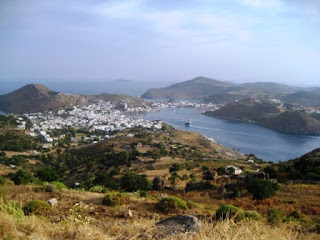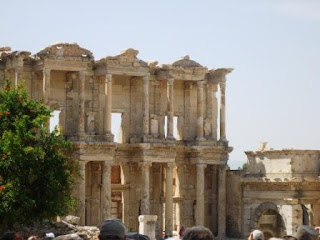Sorry about the delay in getting back to the island hopping account. I hit the "publish" button too soon on the poems (Emphemerality) last time, so I am being cautious here.
Plus, some of the humdrum of daily life has intervened: such as spreading mulch, cutting back chrysanthemums.
I have also spent time fighting V*riz*n on my father's account. That is his ISP for Internet access, and his computer has been unable to find its IP address. So, he and I have spent hour (make that HOURS) on the phone with customer service reps somewhere in the world. I have typed more DOS commands in the last several days than in all my prior years using a computer. And, guess what, he's still NOT back online, despite V*riz*n's assurance to the contrary!
SIGH!
When last we left our heroine, she was on her way to the island of Rhodes. This ancient island has figured prominently in history. Probably best known as the site of the Colossus of Rhodes (one of the 7 wonders of the ancient world), Rhodes has been occupied variously by the Minoans, the Persians, Alexander the Great, the Romans, the Knights Hospitaller (during the Crusades), the Turks during the Ottoman Empire, the Italians, and finally the Greeks when they were united as part of Greece in 1948.
We went to see two sites on Rhodes--Lindos, where the Acropolis (which just means "high city") features the Doric Temple of Athena Lindia, built in 300 BC; and the town of Rhodes.
 The Acropolis of Lindos
The Acropolis of Lindos
 You can see where the steps are leading up to the top--just on the left of the photo.
You can see where the steps are leading up to the top--just on the left of the photo.
 And the crowds of people climbing, climbing, climbing. . .
And the crowds of people climbing, climbing, climbing. . .
 If you wanted to, you could take a donkey ride. Up the steps? I don't think so!
If you wanted to, you could take a donkey ride. Up the steps? I don't think so!
 And once you reach the top, you can see the beginnings of a wonderful view.
And once you reach the top, you can see the beginnings of a wonderful view.
 And some of the reinforcements.
And some of the reinforcements.  More walls to repel or protect.
More walls to repel or protect.
 And the view of the harbor of Lindos below.
And the view of the harbor of Lindos below.
 And the Doric Temple of Athena--the reason we climbed.
And the Doric Temple of Athena--the reason we climbed.
The next site, the town of Rhodes, is in fact a walled city. Built by the Knights Hospitaller, it is touted as the largest extant walled city in Europe. It was built in the 1300s, and withstood many attempted invasions. Portions of the palace there were destroyed in 1856, then rebuilt by the Italians, during their occupation. The town has now been declared a UNESCO World Heritage site, a much appreciated development, as that brings money in for restoration.





 We left Rhodes, and then traveled overnight to the island of Patmos. When we arrived in Patmos, our local guide solemnly informed us that we were going to see the second most holy site in all of Christendom. Her assessment--after Jerusalem, the cave where St. John received the Revelation of the Apocalypse is the second most holy site. Well, I can't dispute someone's individual belief, but it seems to me that this pronouncement is a bit of a stretch.
We left Rhodes, and then traveled overnight to the island of Patmos. When we arrived in Patmos, our local guide solemnly informed us that we were going to see the second most holy site in all of Christendom. Her assessment--after Jerusalem, the cave where St. John received the Revelation of the Apocalypse is the second most holy site. Well, I can't dispute someone's individual belief, but it seems to me that this pronouncement is a bit of a stretch.
 We boarded a bus to ride up the hills on this small island to reach Chora which is nearby the Cave of the Apocalypse. Below we could see Agriolivadi Bay. Just as our bus was climbing, we stopped for a brief photo opportunity--and then the bus engine refused to start. So there we stood. Lovely views all around.
We boarded a bus to ride up the hills on this small island to reach Chora which is nearby the Cave of the Apocalypse. Below we could see Agriolivadi Bay. Just as our bus was climbing, we stopped for a brief photo opportunity--and then the bus engine refused to start. So there we stood. Lovely views all around. The bay below--note the house on the right.
The bay below--note the house on the right.

Isn't this a wonderful house? Could you see living here with the view below?

With these horses in the field next to the house?
 And this goat herder and his goats on the hill above the house? Not a bad place for the bus to break down. Well, our local guide commandeered a passing bus (another tourist bus) and off we went.
And this goat herder and his goats on the hill above the house? Not a bad place for the bus to break down. Well, our local guide commandeered a passing bus (another tourist bus) and off we went.
 Far above us was the Monastery of St. John the Divine--we had opted not to go there, but it was an imposing site nevertheless.
Far above us was the Monastery of St. John the Divine--we had opted not to go there, but it was an imposing site nevertheless.
 Then into the town of Chora, with its lovely little town square. Since we were there on Sunday morning, we watched the elderly ladies getting ready to go to church in Skala, the main town below. They went there so they could visit with their friends and gossip.
Then into the town of Chora, with its lovely little town square. Since we were there on Sunday morning, we watched the elderly ladies getting ready to go to church in Skala, the main town below. They went there so they could visit with their friends and gossip.
 The next stop was the Cave of the Apocalypse. On the off chance you are not up on New Testament literature, the last book in the NT canon is the Book of Revelation. Written by an author named John who tells the reader he was on the island of Patmos when he received his revelation, we know the book was written during a time of Roman persecution of Christians. The author was basically a political (or religious) prisoner who had been exiled to Patmos. The Romans did that--exiled people to islands like Patmos.
The next stop was the Cave of the Apocalypse. On the off chance you are not up on New Testament literature, the last book in the NT canon is the Book of Revelation. Written by an author named John who tells the reader he was on the island of Patmos when he received his revelation, we know the book was written during a time of Roman persecution of Christians. The author was basically a political (or religious) prisoner who had been exiled to Patmos. The Romans did that--exiled people to islands like Patmos.
 That much I have no trouble accepting. Where the skeptic in me comes out is in descriptions of the cave itself. So, how--I ask--do we know it was THIS cave that John was in? And how do we know he was IN a cave when he received his revelation? And how do we know he put his hand on the cave wall, in a niche (now rimmed in silver), as his hand-hold to help him get up? Or how do we know that rock was his "pillow"? My skepticism was pushed right over the top when the guide told us we would see a place in the cave where the rock split into three--proof of the Trinity. Huh? Maybe the rock just split. You see--I am the skeptic.
That much I have no trouble accepting. Where the skeptic in me comes out is in descriptions of the cave itself. So, how--I ask--do we know it was THIS cave that John was in? And how do we know he was IN a cave when he received his revelation? And how do we know he put his hand on the cave wall, in a niche (now rimmed in silver), as his hand-hold to help him get up? Or how do we know that rock was his "pillow"? My skepticism was pushed right over the top when the guide told us we would see a place in the cave where the rock split into three--proof of the Trinity. Huh? Maybe the rock just split. You see--I am the skeptic.
We went down many steps into the cave--where we were NOT allowed to take photographs--and where a Greek Orthodox service was underway. Here is where the men attended Sunday service. I felt somewhat disrespectful walking through the cave, but our guide urged us that it was quite acceptable with the priest. So we all trooped through to the chanting of the Gospel in the three plus hour service.

This photo comes from another website featuring tourist attractions on Patmos.
So the next and final stop on this journey will be mainland Turkey--the ancient town of Ephesus.

 Mt. Gretna was originally intended to be a place for the PA National Guard to hold summer exercises, but it became so much a favored vacation site, that the Guard relocated. A local creek was dammed, and the resulting lake still provides a place for summer swimming. Cabins sprouted up, and in 1899 a camp meeting was established there, built on the Chautauqua model.
Mt. Gretna was originally intended to be a place for the PA National Guard to hold summer exercises, but it became so much a favored vacation site, that the Guard relocated. A local creek was dammed, and the resulting lake still provides a place for summer swimming. Cabins sprouted up, and in 1899 a camp meeting was established there, built on the Chautauqua model.




























































 And this goat herder and his goats on the hill above the house? Not a bad place for the bus to break down. Well, our local guide commandeered a passing bus (another tourist bus) and off we went.
And this goat herder and his goats on the hill above the house? Not a bad place for the bus to break down. Well, our local guide commandeered a passing bus (another tourist bus) and off we went.



